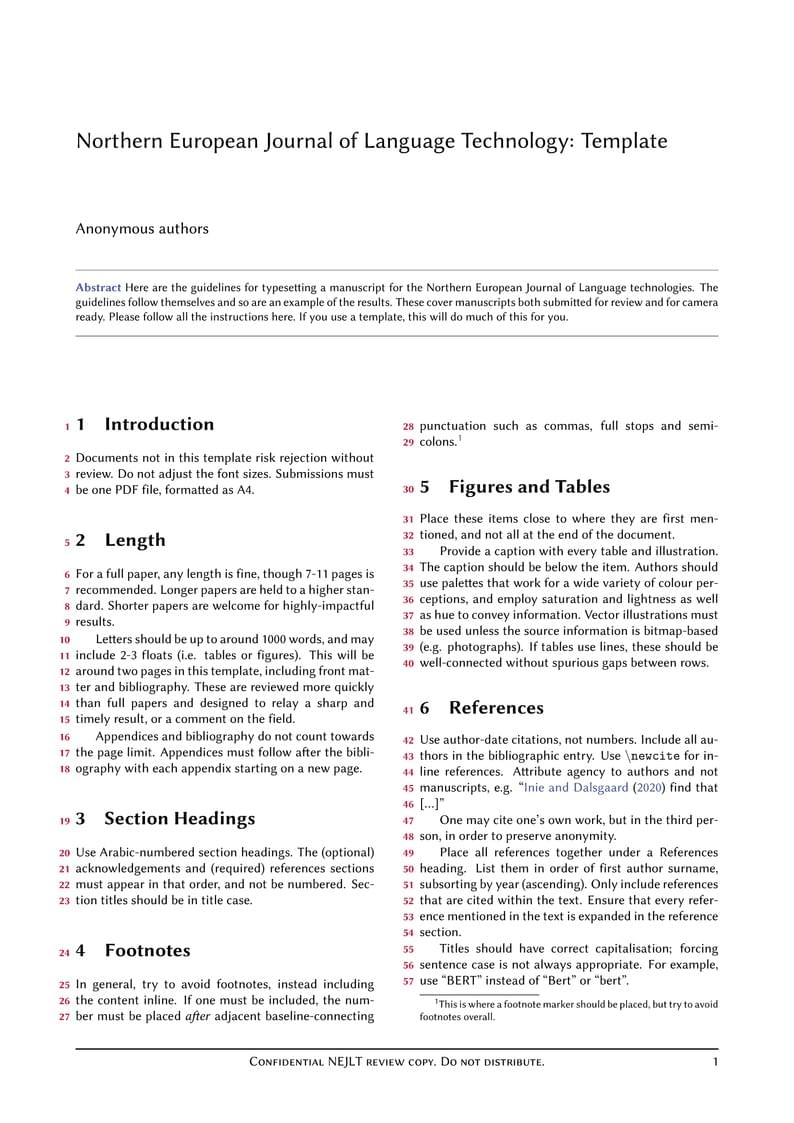
Paper template for the Northern European Journal of Language Technology

% The canonical version of this template is at https://github.com/NEJLT/nejlt-template
\documentclass{article}
% pass the option "final" for camera-ready versions
%\usepackage[final]{nejlt}
% pass the option "letter" for letter submissions
%\usepackage[letter]{nejlt}
% options can be combined with a comma
%\usepackage[final,letter]{nejlt}
\usepackage{nejlt}
% package used only for the template, feel free to remove this
\usepackage{lipsum}
% manuscript title
\title{Northern European Journal of Language Technology: Template}
% running head title here
\chead{Northern European Journal of Language Technology: Template}
\author{
Lois Griffin, {\normalsize Quahog Community College, Rhode Island, USA} \and
Reviewer Two, {\normalsize University of California San Diego, USA {\tt \small strongreject@ucsd.edu}} \and
Margrete Valdemarsdatter, {\normalsize Roskilde, Kalmar Union {\tt \small daisy@hestenettet.dk}} \and
Marc Rebillet, {\normalsize Loop Daddy Institute, YouTube Inc.} \and
Wil E. Coyote, {\normalsize Utopia Planitia, Mars, UFP} % we adopt an Earth/Sol-centric naming scheme: if an author affiliation is based elsewhere, please give the planet/system
}
\begin{document}
\thispagestyle{title}
\abstract{Here are the guidelines for typesetting a manuscript for the Northern European Journal of Language technologies. The guidelines follow themselves and so are an example of the results. These cover manuscripts both submitted for review and for camera ready. Please follow all the instructions here. If you use a template, this will do much of this for you.}
\maketitle
\section{Introduction}
Documents not in this template risk rejection without review. Do not adjust the font sizes. Submissions must be one PDF file, formatted as A4.
\section{Length}
For a full paper, any length is fine, though 7-11 pages is recommended. Longer papers are held to a higher standard. Shorter papers are welcome for highly-impactful results.
Letters should be up to around 1000 words, and may include 2-3 floats (i.e. tables or figures). This will be around two pages in this template, including front matter and bibliography. These are reviewed more quickly than full papers and designed to relay a sharp and timely result, or a comment on the field.
Appendices and bibliography do not count towards the page limit. Appendices must follow after the bibliography with each appendix starting on a new page.
\section{Section Headings}
Use Arabic-numbered section headings. The (optional) acknowledgements and (required) references sections must appear in that order, and not be numbered. Section titles should be in title case.
\section{Footnotes}
In general, try to avoid footnotes, instead including the content inline. If one must be included, the number must be placed \emph{after} adjacent baseline-connecting punctuation such as commas, full stops and semicolons.\footnote{This is where a footnote marker should be placed, but try to avoid footnotes overall.}
\section{Figures and Tables}
Place these items close to where they are first mentioned, and not all at the end of the document.
Provide a caption with every table and illustration. The caption should be below the item. Authors should use palettes that work for a wide variety of colour perceptions, and employ saturation and lightness as well as hue to convey information. Vector illustrations must be used unless the source information is bitmap-based (e.g. photographs). If tables use lines, these should be well-connected without spurious gaps between rows.
\section{References}
Use author-date citations, not numbers. Include all authors in the bibliographic entry. Use {\tt {\textbackslash}newcite} for inline references. Attribute agency to authors and not manuscripts, e.g. ``\newcite{inie2020interaction} find that [...]"
One may cite one's own work, but in the third person, in order to preserve anonymity.
Place all references together under a References heading. List them in order of first author surname, subsorting by year (ascending). Only include references that are cited within the text. Ensure that every reference mentioned in the text is expanded in the reference section.
Titles should have correct capitalisation; forcing sentence case is not always appropriate. For example, use ``BERT" instead of ``Bert" or ``bert".
Do not use an arXiv reference where the paper has also appeared in a peer-reviewed venue. In that case, use the peer-reviewed reference.
For book chapters, use \texttt{\@inbook}, e.g. \citet{swift}.
\section{Non-English worked examples}
The lagnuage of the journal is English.
American English and English English are both fine, as are other spelling and formulation variants.
When discussing non-English languages, please provide translations into English.
When providing and discussing important worked examples, please include interlinear glosses.
The Leipzig style is preferred, \url{https://www.eva.mpg.de/lingua/pdf/Glossing-Rules.pdf}. There are LaTeX packages that support this.
\section{Non-English character rendering}
To render non-English characters, use your favourite method that retains the journal layout and font. Past authors have had success with using XeTeX and the \texttt{libertine} package, and defining a block like:
\begin{verbatim}
\usepackage{libertine}
\newfontfamily\hebfont{Frank Ruehl CLM}
\newcommand{\heb}[1]{{\hebfont #1}}
\setmainfont{Linux Biolinum O}
\end{verbatim}
where \texttt{{\textbackslash}heb} can then be used to wrap text and apply the specified font.
\section{Lipsum Padding}
See~\newcite{inie2020interaction}. \lipsum[4] Details are well-known~\cite{devlin2014fast}.
\begin{table}
\centering
\begin{tabular}{lcc}
\hline
\textbf{System} & \textbf{F1} & \textbf{Variance} \\
\hline
ABC-D & 0.720 & 2.1\% \\
Baseline & 0.671 & 0.9\% \\
\hline
\end{tabular}
\caption{Sample table. Captions go below the table. Avoid superfluous horizontal lines.}
\label{tab:demotable}
\end{table}
\section{Sample Reflections}
See Table~\ref{tab:demotable}. \lipsum[5] Details are given in~\newcite{steedman}.
\section{Sample Discussion}
\lipsum[6] For details, see~\newcite{reviewing}.
\section{Sample Conclusion}
\lipsum[7] Books are cited the same way~\cite{aoett}.
% Acknowledgments is an un-numbered section. Keep them hidden until camera-ready.
\section*{Acknowledgements}
Exclude acknowledgements for review. Add them in an unnumbered section before the bibliography and optional appendices.
\bibliography{nejlt}
\bibliographystyle{nejlt_bib}
\end{document}